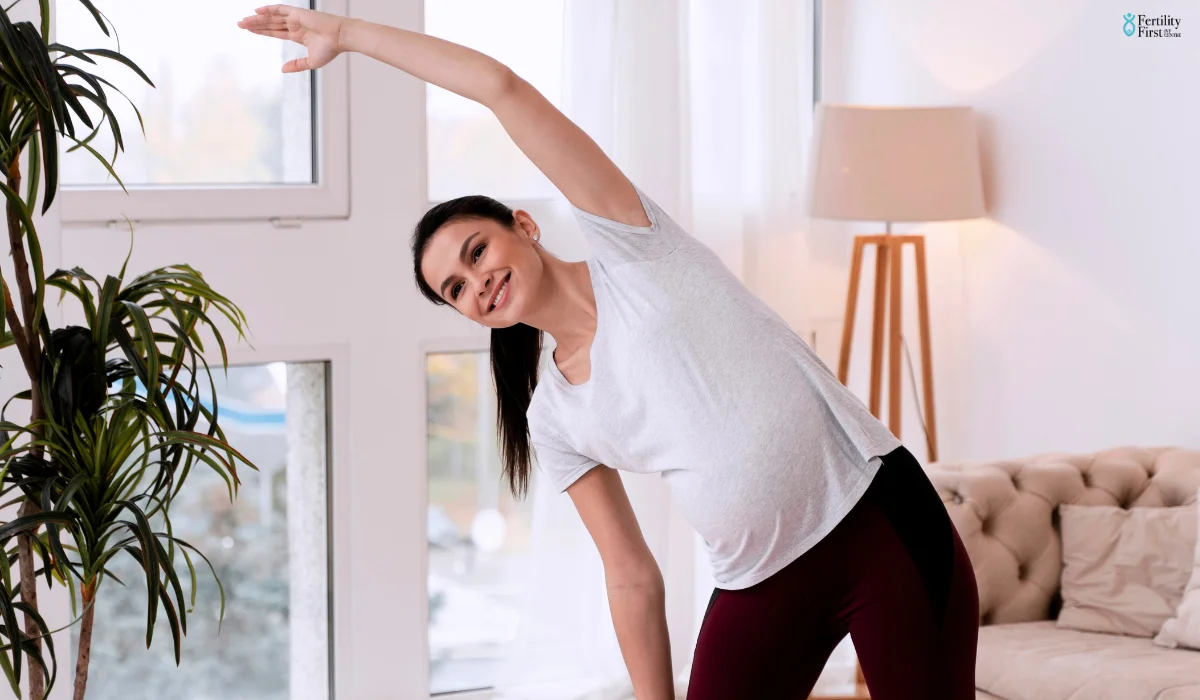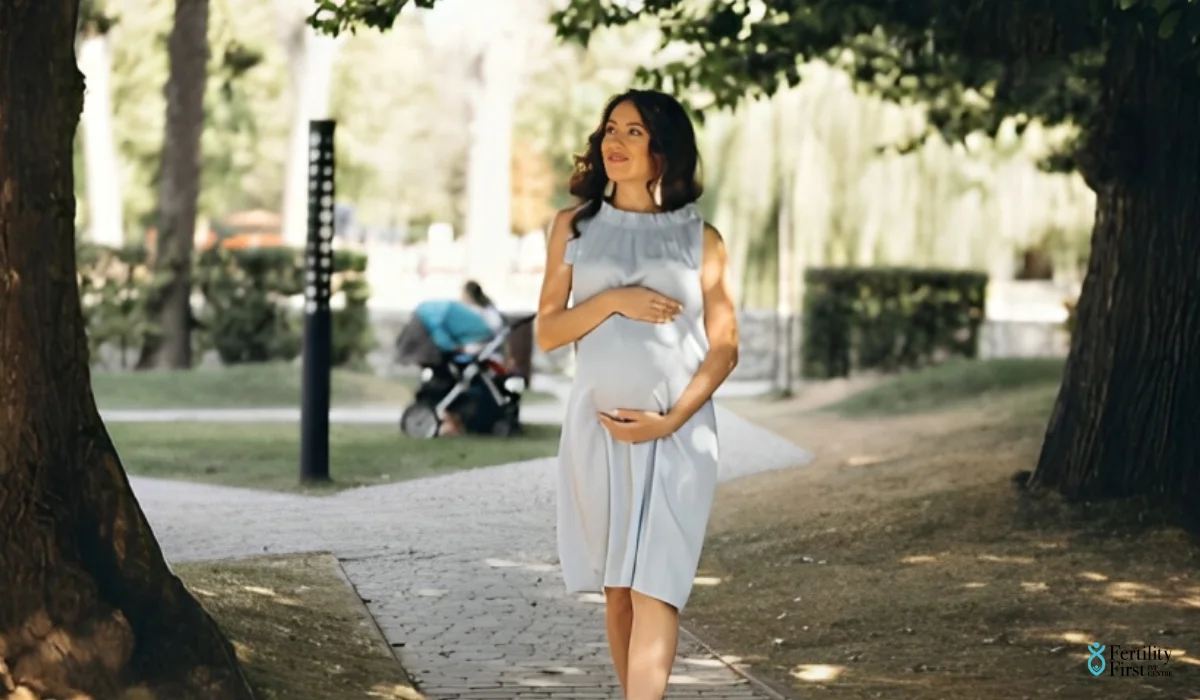Expert’s Guide To The Best Exercises After IVF Transfer

The current article that revolves around the topic, “Best Exercise After IVF Transfer” attempts to achieve a connection between exercise and IVF transfer in the first place. It also serves to analyze the effectiveness of exercises upon successful IVF transfers, being that the latter involves artificial insemination of live eggs. Based on the success-cum-survival rates of the implantation of the formed embryos upon their transfer, what remains is ensuring a safe and live birth of the baby when reaching term.
The importance of exercises has well been contemplated in this regard to further enhance the possibilities of achieving live births, as well as encourage future research on the types of exercises that will benefit intended mothers who have undergone IVF transfers and are truly concerned about safely delivering their babies.
Overview of the IVF Procedure and the Role of Exercise
The IVF procedure, short for in-vitro fertilization is one of those assisted reproductive techniques enabling a couple to conceive when natural measures to become pregnant have failed. The embryo transfer, which is the ultimate step in IVF, facilitates the successful implantation of the embryo within the uterus. The success rate, however, relies on various factors, including age and the time at which the embryos are transferred, earlier or later. It can also be stated that light exercises, for the most part, have a lasting and positive impact on the chances of live births.
Aside from the fact that whether fresh or frozen embryo transfers carry comparative advantages of leading to live births, i.e., 41.4% and 47% respectively, exercise can improve/enhance this to a significant extent, provided that the prospective mothers follow an exercise regime that will at least keep them moving rather than staying sedentary for the duration of their pregnancy.
Best Recommended Exercises After IVF Transfers
Noting that exercising is critical for expectant mothers, especially for those who have become pregnant through assisted reproductive technologies like IVFs and subsequent embryo transfer, some of them have been identified as listed below:
Lifting Weights
The two-week wait between embryo transfer and pregnancy is crucial for women to stay active. Lifting mild weights would, therefore, result in the release of hormones that are essential for fetal growth and development, especially after IVF transfers. However, it is always appropriate to go slow and avoid powerlifting because the intention is to stay as active as possible and not to do strenuous exercises, both during that 2-week wait and after confirmation of pregnancy through the IVF procedure.
Walking

Another of those lightweight exercises, walking happens to be the most preferred workout that any expectant mother, conceived naturally or otherwise, can adhere to. It is also considered to be one of the safest forms of exercise, which encourages pregnant women to stay active as best as possible without fear of the embryo falling off.
Yoga
Unless refrained by the OB/GYN from doing any sort of exercise, women on the two-week waiting period can do light exercises, such as yoga. This will help them to stay active, along with improving/enhancing their chances for a safe and healthy pregnancy journey. Moreover, understanding that the health benefits of yoga are three-fold, especially for expectant mothers, these have included stress reduction, improvement in circulation, and improved flexibility in the pelvic and hip areas. If these three criteria are fulfilled, then safe delivery is guaranteed, making yoga to be one of the most sought-after exercises during pregnancy post-IVF transfer.
Light Stretching
Doing routine stretches at home will help improve flexibility and blood circulation in pregnant women.
Light Hand Weights
As stated above, it is highly safe to avoid strenuous activities in pregnancy following IVF transfer. Opting for light hand weights is one of the best options in this case, as these will improve circulation and flexibility as can be had through yoga.
Besides the ones discussed above, one can also include Tai Chi, Water Aerobics, and Restorative Moves, where these light exercise regimes serve to ease stress, tension, and anxiety associated with pregnancy through assisted reproductive technologies like IVF, thereby paving forth for a safer pregnancy journey and live birth eventually.
Why Is It Important To Exercise After IVF Transfer?
Though it is considered appropriate to stay out of exercise during IVF/embryo transfer for ten weeks, this does not mean that a woman wanting to become pregnant should stay sedentary and without any activity. As stated above, while mild exercises will help one to stay active during the two-week wait time to confirm one’s pregnancy after IVF transfer, engaging in strenuous exercises like powerlifting will indeed cause harm to the implanted embryo, preventing it from growing and developing.
It was also mentioned prior that light exercises, such as lifting light weights stimulate the release of hormones that are essential for the baby’s survival within the womb. Additionally, walking, light yoga, swimming, and Tai Chi help ease the tension and anxiety surrounding pregnancy when this is specifically achieved through assisted reproductive techniques, such as IVF. What could be inferred here is that it is always safe to consider doing the aforementioned mild exercises instead of pushing oneself to more strenuous workouts.
The Inappropriateness of Exercise During IVF Transfer
Though it is highly recommended to stay active and do light-weight exercises during the 2-week wait before confirmation through a pregnancy test post-IVF/embryo transfer, expert medical professionals, especially those working in fertility assistance centers, do not consider it safe to exercise during the IVF cycle or procedure, or at least ten weeks post transfer of the embryos.
This is due to the fear of blood being drawn away from the ovaries and uterus in this period. However, since such a risk is only associated with exercises that involve the movement of the large muscles in the arms and legs, these can be avoided to enjoy a safe pregnancy after embryo transfer.
In lieu of the above statements, further research studies that were carried out to examine the risk of doing exercise after the embryo transfer procedure, it revealed that women who committed to regular (and strenuous) exercises were less likely to have a live birth than those who stayed inactive or involved in mild exercise forms. There was also a finding that regular exercises during the IVF procedure and the stages involved there can likely produce negative outcomes. Needless to state, continuously exercising without breaks for four hours and more every week is likely to adversely affect fetal development as was stressed earlier, resulting in a stillbirth.
Impact of Exercise During IVF Cycle
The two most likely impacts of exercise post-IVF transfer have included the following:
IVF Cycle Cancellation: Studies have delineated that women partaking in cardiovascular exercises carry more possibilities for attaining stillbirths than those who refrain from the same. They are also prone to experience the cancellation of their IVF cycle because of exercising relentlessly and continuously. The mechanism behind this is the play of hormones, those being estrogen and progesterone, where each of these tends to go high or too low. Wondering what has intense exercise to do with these fluctuations and the subsequent cancellation of the IVF cycle is that this tends to cause an imbalance to these hormones, thus hurting the embryo formed via in-vitro fertilization.
Possibility of Implantation Failure or Pregnancy Loss: In regards to what was stated earlier, too much exercise does more harm than good, especially if one indulges in lengthy schedules of the same during the IVF cycle. The odds surrounding stillbirth increase by 40%, which signifies that the remaining 60% can experience success with the IVF procedure if they do not commit to strenuous exercising during the IVF cycle. Additionally, the negative outcomes of IVF-induced pregnancy imposed by strict exercise schedules are enough to account for pregnancy losses. If one does not adhere to the specifications of the IVF procedure, one is more likely to experience failure there.
Related: IVF Cycle: A Step-By-Step Guide On This Complex Procedure!
Conclusion
The article primarily dealt with identifying the best exercises after IVF transfer, wherein it was identified that mild exercises like light weight lifting, yoga, swimming, Tai Chi, rotational moves, etc., will prove helpful for the safe implantation and subsequent growth and development of the embryo. At the same time, however, committing to strenuous exercise schedules will markedly increase the risk of the IVF cycle, causing stillbirth in the event. Thus, as stated above, it is recommended to wait for at least ten weeks post-pregnancy test after the embryo has been successfully implanted, either from fresh eggs or frozen ones.
